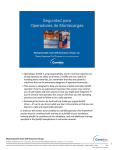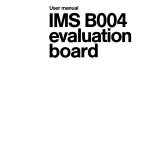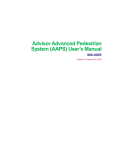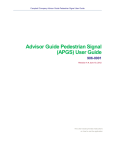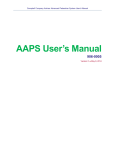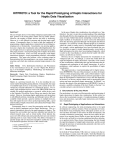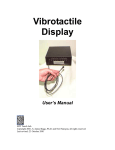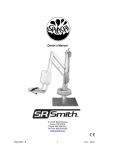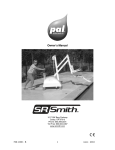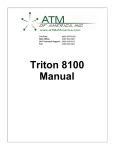Download DMS-11132 Accessible Pedestrian Signals
Transcript
Departmental Materials Specification DMS-11132 DMS-11132 Accessible Pedestrian Signals Effective Date: January 2015 1. DESCRIPTION This Specification describes the minimum acceptable design and performance requirements for Accessible Pedestrian Signals (APS). 2. UNITS OF MEASUREMENTS The values given in parentheses (if provided) are not standard and may not be exact mathematical conversions. Use each system of units separately. Combining values from the two systems may result in nonconformance with the standard. 3. MATERIAL PRODUCER LIST The Traffic Engineering Section of the Traffic Operations Division (TRF-TE) maintains the Material Producer List (MPL) of all materials conforming to the requirements of this Specification. Materials appearing on the MPL, entitled “Traffic Signals,” require no further sampling and testing before use unless deemed necessary by the Project Engineer or TRF-TE. 4. BIDDERS’ AND SUPPLIERS’ REQUIREMENTS The Department will only purchase or allow on projects those products listed by manufacturer and product code or designation shown on the MPL. Use of pre-qualified product does not relieve the Contractor of the responsibility to provide product that meets this Specification. The Department may inspect or test material at any time and reject any material that does not meet the specifications. All equipment furnished in compliance with this Specification must be new and unused. 5. PRE-QUALIFICATION PROCEDURE 5.1. Pre-Qualification Request. Submit a request for evaluation under DMS-11132 to [email protected]. Include the following information in the request: manufacturer's name; ISO 9001:2008 certification; physical and mailing addresses; contact person, phone number, and email address; brand and model number; and product data sheet. 5.2. Pre-Qualification Sample. Prior to shipping any samples, contact the Traffic Signals Branch at (512) 506-5100. Ship one sample from a normal production run of the APS requesting acceptance to the Texas Department of Transportation, TRF-TE-CP, 9500 North Lake Creek Parkway, Austin, Texas 78717. Traffic Operations Division 1 – 10 Effective Date: January 2015 Departmental Materials Specification DMS-11132 The sample must include all components needed to deploy the APS at a signalized intersection. Provide 4 pushbutton stations (PBS) as part of the sample. Include the following with the sample: manufacturer’s name; brand and model number; letter from the manufacturer confirming compliance with this Specification; certified independent laboratory reports in accordance with Article 5.3 of this Specification, if requested; one schematic diagram per model, along with any necessary installation instructions; complete and accurate installation wiring guide; user manual; and 60-month full warranty as specified in Article 7 of this Specification. Provide additional samples when directed. Submit all products for pre-qualification at no cost to the Department. 5.3. Independent Laboratory Testing. Independent laboratory testing must be performed and documented by a Nationally Recognized Testing Laboratory (NRTL). Provide certified independent laboratory reports confirming all parts of the APS are compliant with: NEMA TS 2 Section 2.2.7, “Test Procedure: Transients, Temperature, Voltage, and Humidity”; NEMA TS 2 Section 2.2.8, “Vibration Test”; NEMA TS 2 Section 2.2.9, “Shock (Impact) Test”; and FCC Title 47, Part 15, Class A electronic noise requirements. Provide certified independent laboratory reports confirming the PBS of APS is compliant with NEMA 250, “Enclosures for Electrical Equipment (1000 Volts Maximum),” Type 4X enclosure. Provide certified independent laboratory reports confirming the PBS control unit (CU) and any other parts of APS that are installed in traffic signal cabinet are compliant with NEMA 250, “Enclosures for Electrical Equipment (1000 Volts Maximum),” Type 1 enclosure. 5.4. Sampling and Testing. TRF will set up the APS in the Department’s TS-2 traffic signal control cabinet in accordance with the manufacturer’s written installation instructions and will test to the latest NEMA TS 2 environmental standards. All APS components must be operational at the conclusion of the test and must not cause MMU trip conditions in the controller/cabinet during testing. TRF will verify that the APS is constructed and operates according to this Specification. 5.5. Evaluation. TRF will return to the submitting party a letter of confirmation or rejection for each model submitted. For each rejected model, TRF will issue a test report along with the letter of rejection. 5.5.1. Qualification. If approved for Department use, TRF will add the product model number to the MPL. Any deviation in product design after Department testing and approval constitutes a new model, which must be resubmitted for acceptance. Manufacturers that determine there is reason to remove a model from the MPL must submit a letter to TRF identifying the problem. TRF will remove the model without prejudice. Once the problem has been resolved to TRF’s satisfaction, the manufacturer may apply for re-qualification for the new model. Traffic Operations Division 2 – 10 Effective Date: January 2015 Departmental Materials Specification DMS-11132 All submitted materials become the property of the Department. 5.5.2. Failure. Products not qualified under this Specification may not be furnished for use on Department projects and must be corrected of all deficiencies before reconsideration for qualification. If products fail to meet any of the specification requirements, the manufacturer may not resubmit for qualification until 1 year from original evaluation date. TRF may waive this time limit if provided with documentation from an independent testing facility stating the product meets all requirements. TRF will enforce the 1-year time limit if, after retesting, the product again fails any of the specification requirements. The Department normally bears the costs of sampling and testing; however, the manufacturer will bear the costs associated with materials failing to conform to the requirements of this Specification. The Director of TRF will assess this cost at the time of testing for each recurring non-compliant submittal, and amounts due will be billed to the manufacturer. TRF will not re-test products until costs for previously failed tests have been paid. 5.6. Periodic Evaluation. The Department reserves the right to conduct random sampling and testing of pre-qualified products to verify performance and Specification compliance and to perform random audits of documentation. The quantity of each model in the shipment will determine the number of modules tested. The sample size will conform to ANSI/ASQC Z1.4. TRF will determine the sampling parameters used for the random sample testing. All parameters of the specification may be tested on the modules. Acceptance or rejection of the shipment will conform to ANSI/ASQC Z1.4 for randomly sampled shipments. Failure of products to comply with the requirements of this Specification as a result of periodic evaluation may be cause for removal of those products from the MPL. In case of variance, the Department’s tests will govern. 5.7. Disqualification. Causes for disqualification and immediate removal from the MPL include, but are not limited to: problems are present with the APS (e.g., unsafe failure condition or excessive failure rate); the Department receives excessive complaints about a manufacturer’s compliance with the warranty requirements of Article 7; manufacturer deviates the APS from pre-qualified units without prior Department testing and approval; product fails to meet the requirements of this Specification as a result of periodic evaluation; or manufacturer has unpaid charges for failing samples. If TRF removes a model from the MPL for cause other than manufacturer’s recommendation, the manufacturer may not resubmit for approval for a minimum of 1 year, at the discretion of the Department. TRF will reinstate a model on the MPL under a different model number if all problems identified have been corrected such that the new model does not exhibit the same problems. TRF must approve the new model as a successful replacement. 5.8. Re-Qualification. Once the disqualification period established by TRF has elapsed, manufacturers disqualified and removed from the MPL may begin the re-qualification process by submitting a request in accordance with Section 5.1, including additional documentation identifying the cause of the problem and corrective action taken. The APS may not be re-qualified under the same model number. The APS must be submitted under a different model number and undergo the full qualification process as required by this Specification. The Department normally bears the costs of sampling and testing; however, the disqualified manufacturer will bear the costs associated with re-qualification. The Director of TRF will assess this cost at the time of re- Traffic Operations Division 3 – 10 Effective Date: January 2015 Departmental Materials Specification DMS-11132 evaluation, and amounts due will be billed to the manufacturer. TRF will not re-test products until costs for previously failed tests have been paid. 6. DOCUMENTATION REQUIREMENTS Provide all APS with the following documentation: complete and accurate installation wiring guide; user manual; contact name, address, telephone number, and email address or webpage for the representative, manufacturer, or distributor for warranty repair; schematics for all electronics, if requested by the purchaser; and 60-month full warranty as specified in Article 7. Manufacturers must be International Organization for Standardization ISO 9001:2008 certified or latest revision. 7. WARRANTY REQUIREMENTS Manufacturer must comply with all requirements of the following full warranty. Failure to comply with the requirements of this full warranty is cause for removal from the MPL. The manufacturer/provider must submit a full warranty indicating understanding of and willingness to abide by the provisions of this Specification. The manufacturer/provider must provide the name and telephone number of the person to contact regarding potential claims under the provisions of this warranty. Include the warranty with the product. The APS must be warranted against any failure due to design, workmanship, or material defects within the first 60 months of field operation. The APS must meet or exceed minimum requirements of this Specification for at least 60 months of field operation. The Department will require repair or full replacement if an APS fails to operate as specified under normal operating conditions. Provide repaired or replaced parts at no cost to the Department. The repaired or replaced APS will inherit the remainder of the failed unit’s warranty. Repair or replace APS within 5 business days after receipt of failed APS at no cost to the Department. The cost of shipping, in both directions, will be borne by the responsible vendor or manufacturer. The manufacturer/provider must submit a full warranty with each lot or shipment stating that the APS provided meets all the requirements of this Specification. The warranty must show individual lot numbers and manufacture dates (minimum week and year) in an easy to understand format. The Department reserves the right to select an APS from the field during the warranty period and perform evaluation tests to determine extended compliance to this Specification. The Department will immediately remove from the MPL any APS that fails to meet the requirements of this Specification during the warranty period, and the submitting party may be held legally responsible for all damages. 8. MATERIAL REQUIREMENTS 8.1. Definitions. Accessible Pedestrian Signal (APS)—a device that communicates information about pedestrian signal timing in non-visual format such as audible tones, speech messages, and vibrating surfaces. Accessible Pedestrian Signal Detector—a device designated to assist pedestrians with visual or physical disabilities in activating the pedestrian phase. Traffic Operations Division 4 – 10 Effective Date: January 2015 Departmental Materials Specification DMS-11132 Actuation—initiation of a change in or extension of a traffic signal phase through the operation of a pushbutton or other type of detector. DONT WALK Interval—steady orange DONT WALK or an UPRAISED HAND symbol used when pedestrians are not supposed to be in the crosswalk. Extended Pushbutton Press—a pushbutton press longer than 1 second. Pedestrian—a person on foot, in a wheelchair, on skates, or on a skateboard. Pedestrian Change Interval—an interval during which the flashing UPRAISED HAND signal indication (symbolizing DONT WALK) is displayed. Pedestrian Clearance Time—the time provided for a pedestrian crossing in a crosswalk, after leaving the curb or shoulder, to travel to the far side of the traveled way or to a median. PED Recall—WALK indication given every cycle (as though a pedestrian were always there pushing the button). Pilot Light—indicates actuation. Pushbutton—a button to activate a device or signal timing for pedestrians, bicyclists, or other road users. Pushbutton Information Message—a recorded message that can be actuated by pressing a pushbutton when the walk interval is not timing that provides the name of the street that the crosswalk associated with that particular pushbutton crosses and can also provide other information about the intersection signalization or geometry. Pushbutton Locator Tone—a repeating sound that informs approaching pedestrians that a pushbutton exists to actuate pedestrian timing or receive additional information and that enables pedestrians with visual disabilities to locate the pushbutton. Pushbutton Station (PBS)—a single unit containing a pedestrian sign, a pushbutton, a vibrotactile arrow, and an audible speaker. Rest-in-WALK—the pedestrian signal to cross the minor street remains in WALK as long as the major street has green and there is no call on the minor street. When an approaching vehicle is detected on the minor street, the pedestrian signal to cross the minor street changes to flashing DONT WALK. WALK interval—white WALK or WALKING PERSON symbol issued to indicate that pedestrians should begin crossing, after yielding to vehicular traffic still legally in the crosswalk. 8.2. General. APS must comply with and operate consistent with requirements of the latest Texas Manual on Uniform Traffic Control Devices (TMUTCD), Chapter 4E, “Pedestrian Control Features.” In case of conflict between standards and specifications, this Specification will govern. The information provided by an APS must clearly indicate which device (such as an APS pushbutton station) serves each pedestrian crossing. Under stop-and-go operation, APS must not be limited in operation by the time of day or day of week. Provide APS that are integrated into the pedestrian detector (pushbutton station). APS must be capable of audible tones and messages. Provide accessible pedestrian pushbutton stations with the following features: pushbutton locator tone, ADA compliant with raised vibrotactile arrow on the button plunger, speech walk message for the WALKING PERSON (symbolizing WALK indication), and speech pushbutton information message. Traffic Operations Division 5 – 10 Effective Date: January 2015 Departmental Materials Specification 8.2.1. DMS-11132 Walk Indications. Each pushbutton must activate both the WALK interval and the APS. The accessible walk indication must have the same duration as the pedestrian walk signal except when the pedestrian signal rests in WALK. If the pedestrian signal rests in WALK, the accessible walk indication must be limited to the first 7 seconds of the WALK interval (or user settable interval). The accessible walk indication must be recalled by a button press during the WALK interval provided that the crossing time remaining is greater than the pedestrian change interval. APS must have both tactile and audible tone walk indications that meet TMUTCD requirements. 8.2.1.1. Tactile Walk Indications. Provide tactile arrows located on the pushbutton that have high visual contrast (light on dark or dark on light) and can be aligned parallel to the direction of travel on the associated crosswalk at the time of installation. Tactile arrows must be vibrotactile, providing a constant vibration of up to a 20 Hz/second during the WALK interval. 8.2.1.2. Audible Tone Walk Indications. Provide an audible tone walk indication during the walk interval only. The audible tone walk indication must be audible from the beginning of the associated crosswalk. Audible tone walk indications must repeat at 8–10 ticks per second and must consist of multiple frequencies, with a dominant component at 880 Hz. Automatic volume adjustment in response to ambient traffic sound level must be provided up to a maximum volume of 80 dBA. PBS must be able to produce an alert tone—a very brief burst of high-frequency sound at the beginning of the audible walk indication that rapidly decays to the frequency of the walk tone—to alert pedestrians to the beginning of the walk interval. Following the audible walk indication, accessible pedestrian signals must revert to the pushbutton locator tone during the pedestrian change interval. 8.2.1.3. Speech Capability. Speech walk messages used at intersections having pedestrian phasing concurrent with vehicular phasing must be patterned after the following model: “Broadway. Walk sign is on to cross Broadway.” Speech walk messages used at intersections having exclusive pedestrian phasing must be patterned after the following model: “Walk sign is on for all crossings.” Speech walk messages must not contain any additional information, except they must include designations such as “Street” or “Avenue” where this information is necessary to avoid ambiguity at a particular location. A speech walk message is not required at times when the walk interval is not timing, but if provided: must begin with the term “wait” and need not be repeated for the entire time that the walk interval is not timing. 8.2.1.4. Pilot Light. Provide a pilot light with each pedestrian pushbutton. The pilot light must not be illuminated until actuation. Once actuated, the pilot light must remain illuminated until the pedestrian’s green or WALKING PERSON (symbolizing WALK) signal indication is displayed. Since a pilot light is required, each pushbutton actuation must be accompanied by the speech message “wait.” Traffic Operations Division 6 – 10 Effective Date: January 2015 Departmental Materials Specification 8.2.2. DMS-11132 Pushbutton Locator Tones. Provide accessible pedestrian pushbutton stations that incorporate a locator tone. Pushbutton locator tones must have a duration of 0.15 seconds or less and must repeat at 1-second intervals. Pushbutton locator tones must be capable of being deactivated when the traffic control signal is operating in a flashing mode. The locator tone for traffic control signals or pedestrian hybrid beacons activated from a flashing or dark mode to a stop-and-go mode by pedestrian actuations must be capable of normal operation. Pushbutton locator tones must be intensity responsive to ambient sound and be audible 12 feet from the pushbutton. The maximum volume of the locator tone must be 100 dBA. 8.2.3. Extended Pushbutton Press Features. When an extended pushbutton press is used to provide any additional features, a pushbutton press of less than 1 second must actuate only the pedestrian timing and any associated accessible walk indication, and a pushbutton press of 1 second or more must actuate the pedestrian timing, any associated accessible walk indication, and any additional features. Provide an extended button press capable of being configured to request a longer WALK interval or pedestrian change interval for subsequent clearance interval. If additional crossing time is provided by means of an extended pushbutton press as indicated in the Contract, a “PUSH BUTTON FOR 2 SECONDS FOR EXTRA CROSSING TIME” (R10-32P) plaque must be provided and mounted adjacent to or integral with the pedestrian pushbutton. Provide capability of speech pushbutton information messages actuated by an extended button press. Messages must only be actuated when the WALK interval is not timing. Messages must begin with the term “wait,” followed by intersection identification information modeled after, “Wait to cross Broadway at Grand.” If information on intersection signalization or geometry is also given, it must follow the intersection identification information. For additional message format guidance, refer to “Accessible Pedestrian Signals—A Guide to Best Practices (NCHRP Web-Only Document 117A),” 2008 Edition (Transportation Research Board—TRB). 8.3. Functionality. 8.3.1. PBS. Each PBS must have an APS system unique ID. Each PBS of the same manufacture and model must be interchangeable for APS maintenance and expandability. All set-up options must be user-configurable in the field. Each PBS must be capable of operating at a minimum of 1,000-foot conduit run from traffic signal cabinet using AWG#12 wire. 8.3.1.1. Housing. Provide a housing unit consisting of a base housing and a removable cover. Materials other than cast aluminum may be used in conjunction with aluminum, provided the enclosure demonstrates the same performance as a similar cast aluminum enclosure, in respect to the effects of mechanical impacts, environmental conditions, cosmetic surface changes, and temperature cycles. Ensure the internal components provide a pushbutton with all the electrical and mechanical parts required for operation. Supply housing or an adapter (saddle) that conforms to the pole shape, fitting flush to ensure a rigid installation. Supply adapters of the same material and construction as the housing. Close unused openings with a weather-tight closure painted to match the housing. The exterior must be powder coated. The color scheme must be high contrast, with the primary color being yellow. Traffic Operations Division 7 – 10 Effective Date: January 2015 Departmental Materials Specification DMS-11132 8.3.1.2. Pedestrian Sign. Provide each PBS with a 9 × 15-in. sign. Use sheet aluminum with minimum thickness of 0.080 in. for information signs for push buttons. Refer to the Standard Highway Signs (SHSD) for Texas for approved sign design. If the Contract or plans do not specify, provide double-sided signs of R10-3eR(L) (with right and left arrows on opposite sides) for the PBS stations. If the Contract or plans require the use of Braille or raised print, refer to “Americans with Disabilities Act Accessibility Guidelines for Buildings and Facilities” (ADAAG). 8.3.1.3. Pushbutton. Pushbutton must be 2 in. in diameter with a raised vibrotactile arrow, be ADA-compliant, and have a mechanical life of 1 million actuations minimum. The raised arrow on the pushbutton must be made of corrosion-resistant metals. The force required to activate the pushbutton must be 5 lb. (22 N) maximum. Provide passive vibration isolation of PBS housing from the button so that the vibrations are not transmitted to the other APS PBS installed on the same pole. The orientation of the tactile arrow on the pushbutton must be adjustable at the time of installation without the need of special tools. If specified by the Contract or plans, provide a double-headed arrow for use in medians. 8.3.1.4. Audio. Provide a weather-resistant speaker in the PBS housing that is protected by a vandal-resistant screen. Locator tone and WALK audible feature must have independent settable minimum and maximum volume limits. All APS messages for all PBS assigned to the same phase must be synchronized. (E.g., WALK sign is ON, plays at both ends of the crosswalk.) The PBS must have an independent ambient adjustment setting for the locator tone that allows the volume to be set to play below the ambient noise level. Provide an ambient sensing microphone located in the PBS in a non-visible, environmentally protected housing. The microphone must be omnidirectional. The PBS must utilize high quality digital audio playback technology to produce clear voice messages from quality audio recordings at maximum volume setting. Provide capability to adjust the volume wirelessly. Disable wireless in normal operating mode. 8.3.1.5. Conflict Walk Monitor. Provide conflict walk monitoring capability via firmware or additional hardware. The PBS is reset in case of a conflict detection. 8.3.2. Control Unit (CU). Provide a PBS control unit (CU) that resides in the traffic signal cabinet and is capable of controlling up to 4 pedestrian phases and 16 PBSs with a means of providing additional inputs on more pedestrian phases for complex intersection phasing. 8.3.2.1. Wiring. Provide any wiring harnesses, connectors, interface cables, SDLC cables, termination panels, terminal blocks, etc. required for connecting the PBS or CU to the traffic signal controller assembly and making the PBS operational. 8.3.2.2. Enclosure. The overall CU physical design must be shelf mounted or must fit into the detector card rack. Shelf-mounted CU must be designed so that the weight of the cables and harnesses do not pull the CU off the shelf. Traffic Operations Division 8 – 10 Effective Date: January 2015 Departmental Materials Specification DMS-11132 Provide easy access to configuration and communication ports, buttons, and status displays. Ensure that wiring harness power cords are out of the way once wired into the traffic signal cabinet and connected to the CU. 8.3.2.3. Component. Provide internal non-volatile memory to store 256 events with a date-time stamp for each event. Provide an internal software-settable, hardware real-time clock (RTC). The clock must track, as a minimum, seconds, minutes, hours, day of month, month, and year. The RTC must provide 1-second accuracy within 0.1-second resolution. RTC drift must be less than ± 1 minute per 30 days at 25°C. The RTC must maintain time/date for a minimum of 30 days without cabinet power applied to the controller and over the full operating temperature range. The RTC must maintain time/date for a minimum of 7 days when standby power support from the CU’s power supply is not available (either disconnected or depleted). The RTC must provide automatic leap year and daylight savings time adjustment that has user-changeable settings. Provide an IP-addressable Ethernet port for remote monitoring. 8.3.2.4. Conflict Monitoring. The CU must have 2 built-in conflict monitoring systems. The first system monitors the PBS and the pedestrian signal lights and powers off the channel upon a conflict. The second system monitors communication between the PBS buttons and CU and resets the CU if internal communication fails. The CU must have user-selectable options to put the intersection into flash if a malfunction is not repaired within a specified period. 8.3.3. Configuration. If a special device or software is required to configure the APS operation, provide a minimum of 1 device or copy of software per signal cabinet along with any required connectors, unless required otherwise by the Contract or plans. Any special device must be hand-held and wireless with a communication range of at least 12 inches from the PBS. The software must be compatible with Microsoft Windows 7 or current version used by the Department and run without needing admin rights; otherwise, provide a built-in web-based setup page with desktop and mobile layouts. Provide capability to adjust settings and troubleshoot APS wirelessly. Disable wireless in normal operating mode. All field selectable options must be settable via Ethernet or USB with password security. Provide control to a minimum of 4 pedestrian channels, receiving its timing from the WALK and DONT WALK signals or the signal controller on SDLC bus. Provide a minimum of 2 time-of-day plans. Provide ability to self-test all PBSs including communication link and put a channel into recall should a PBS fail the self-test and log the event. The firmware and voice messages must be updatable via the USB port or Ethernet port that is located at the PBS or Control Unit. There must be no requirement for the hardware to be changed out to update. Firmware for the CU must be updatable by USB port or Ethernet port on the CU. Provide a mechanism to verify that the update was successful (e.g., checksum). The user must be able to configure the APS, verify its status, and download reports via computer. Provide context-sensitive help. Provide means to duplicate PBS settings/voice messages to accommodate a knock-down, damaged PBS. Traffic Operations Division 9 – 10 Effective Date: January 2015 Departmental Materials Specification DMS-11132 8.3.4. Environmental Requirements. The APS must maintain all programmed functions when the operating ambient temperature range is -30–165°F (-34–74°C). In addition: APS must meet the temperature and humidity requirements of NEMA TS 2, Section 2.1; APS must meet the mechanical shock and vibration requirements of NEMA TS 2, Section 2.1; and PBS enclosure must meet Type 4 enclosure requirements of NEMA 250. 8.3.5. APS Identification Label. Permanently identify each major component of the APS with the manufacturer name or trademark, manufactured date (minimum week and year), and other necessary identification. 8.4. Electrical Requirements. 8.4.1. General. The APS must be capable of using stranded No. 12 AWG XHHW wire with 600-volt insulation. The APS must meet the electrical reliability requirements of NEMA TS 4, Section 8. The APS must have no field replaceable fuses, and all fuses must be self-resetting. 8.4.2. Push-Button Station. Ensure the push-button assembly is weather-tight and tamper-proof, is designed to prevent an electrical shock under any weather condition, has provisions for grounding in accordance with the NEC, and is in compliance with the Americans with Disabilities Act (ADA).The voltage to the PBS must not exceed 24 V. PBS must be capable of being easily retrofitted in existing intersections by utilizing the existing pedestrian input wire pair. The terminals must be sized for AWG 10-18 hook-up wire and must accommodate #6-10 spade connectors. The hook-up terminal must remain intact after a knock-down. 8.4.3. Interconnect (Termination) Board. If used, the APS system must allow the field wiring from the PBS to terminate on an interconnect board inside the cabinet using #6-10 spade connectors. There must be enough positions on the interconnect board to accommodate for all the field wiring without crowding of the termination points. 8.4.4. Power Supplies. The CU must be installed inside the Traffic Cabinet and be powered by the AC supply mains (115 VAC). Allow multiple ways to wire the CU into the power of the cabinet. 8.4.5. Voltage Range. The APS must operate within the NEMA TS 2 Standard. 8.4.6. Transient Voltage Protection. The APS must meet the transient voltage protection requirements of NEMA TS 2, Section 2.1. Ensure that all inputs and outputs on the CU have transient voltage protection. 8.4.7. Electronic Noise. The APS must meet the Class A electronic noise requirements of FCC Title 47, Part 15. 8.4.8. Controller Assembly Compatibility. The APS must be compatible with equipment on the MPL for Traffic Signals. Traffic Operations Division 10 – 10 Effective Date: January 2015










